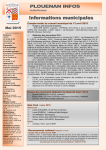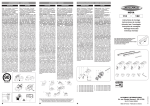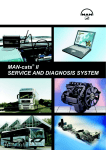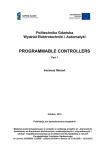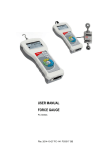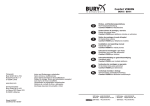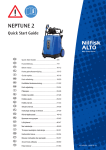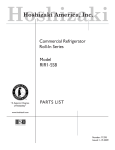Download Imię, Nazwisko autora 1
Transcript
Article citation info: CHWIST, M., ZYCH, M., JAMROZIK, A. Error analysis of the engine control unit in trucks diagnosis. Combustion Engines. 2013, 154(3), 915-923. ISSN 0138-0346. PTNSS–2013–SC–170 Mariusz CHWIST Michał ZYCH Arkadiusz JAMROZIK Error analysis of the engine control unit in trucks diagnosis Abstract: Today an effective control of the work a car is possible thanks to a diagnostic tester which works on OBDII/EOBD systems. In this paper functions of diagnostic devices for trucks were presented and we can see a servicing test with diagnostic computer system. Damaged engine drivers were analyzed, for example errors registered in service station. Keywords: On-Board Diagnostic OBD, heavy duty vehicles, drive unit Analiza błędów sterownika silnika w diagnostyce pojazdów ciężarowych Streszczenie: Obecnie skuteczna kontrola pracy pojazdu samochodowego jest możliwa dzięki wykorzystaniu testerów diagnostycznych pracujących w oparciu o system OBD II/EOBD. W pracy przedstawiono funkcje diagnoskopów do pojazdów ciężarowych oraz pokazano przebieg badania serwisowego z zastosowaniem komputerowego systemu diagnostycznego. Poddano analizie wybrane awarie sterownika silnika, na przykładzie zarejestrowanych błędów w stacji obsługi pojazdów. Słowa kluczowe: system diagnostyki pokładowej OBD, pojazdy ciężarowe, jednostka napędowa We have to register this parameter if we want to correct OBD II system: engine load, engine temperature, speed rotation, pressure in intake manifold fuel pressure, supply voltage, AFR of the mixture, correction rate time of opening injectors, vehicle speed, course of the vehicle and information about defect. We have to know that basic notion used in on-board diagnostic of a vehicle is “monitor”. It is a diagnostic procedure which is controlled by a central computer and it uses hardware and program. It stores the result of the test which has been done doing and it informs the user about the defect. It is true that one monitor serves only one subsystem (or component), so the amount used by monitor depends on the type of engine. We are marking out monitors [16]: - continuous (they watch above elements and components which are controlled “all time” in drive time), - conditional (in this elements are necessary longer time to identify defect – longer time to observation). Circuit OBD II/EOBD about which we talk use two types of codes [22]: - type A (errors that are responsible for increase in exhaust gas toxic components and next causes turn on control indicator immediately after error), - type B (also they cause increase in exhaust gas toxic components but slower than in type A indicator is turning on when error will be twice time). If we want to turn off the lamp, we will have to delete error or delete error code in computer memory but only we uses diagnostic device or turn off power which supply driver. 1. Introduction The progress of today’s motorization means improvement in efficiency of internal-combustion engines and reduction of emission harmful substances to the air [1-10]. Today’s constructors face these requirements and they are restricted with onboard diagnostic systems OBDII and EOBD. Standard OBD (On-Board Diagnostic) was introduced in 1996 in USA and was announced as a global standard in 2000. It forced manufacturers to build on-board diagnostic systems to every type of car – passenger or trucks. The essential function of these systems, is measurement and monitoring of the basic parameters of a powertrain Above all there are critical emission parameters (they affect indirectly or directly the increasing emission from the exhaust system or fuel supply system). The priority for OBD system is elimination of many onboard systems measuring and diagnosing and replacing it with one universal and unified on-board system. Due to this system it is possible to control and diagnostic a drive unit and all vehicles. A European counterpart of OBD or OBDII system is system EOBD (European On-Board Diagnostic) [11-21]. Main assumptions of OBD II system are: - the necessity to inform the driver with MIL lamp about the problems with emission of toxic components, - the necessity to equip vehicles with electronic circuits which check if all the sensors combined with the driver are correct (errors are saved in memory ECU), - the collection of information which is saved in the driver with a possibility to read it. 915 Fig. 1. Tasks OBD II system [11] Maintaining optimal thermal conditions in Airtronic D2/D4 the cargo compartments and cabins. The trucks are placed unusual systems in cars such as: digital tachograph system, which is required by law, and should be installed in any truck with a total weight exceeding 3.5T. This system is connected to the PC board and supervised. If you detach it or exchange, a communication error is signaled from the tachograph. Tachograph addition, every year is controlled and calibrated. Selective catalytic reduction (AdBlue) also occurs mainly in trucks, it is connected to the on-board diagnostic system and is designed to urea dosing to optimize exhaust gas purification from nitrogen oxides. The braking system, although present in both passenger vehicles and trucks is structurally different in both cases. In truck system it is responsible for more wheels. There are air brakes often electrically operated. In addition to these are correct synchronization brakes on the tractor and trailer. The long braking lorry traditional brakes overheat so additional retarder is installed, the electric retarder or hydrokinetic, which is also controlled by the on-board computer. Another system that is unique in cars, the semi-protection system against theft. Start driving is possible only when you connect the trailer to the tractor and after entering deprotecting brakes code. Electrical system is also different in terms of power, used in passenger vehicles is 12V and 24V trucks, the whole apparatus: solenoids, relays, electric motors, lighting is different in structure. 2. Control devices in heavy duty vehicles Monitoring and control of the truck to work properly is a process more complex than in the case of a passenger car. Truck manufacturers equip their vehicles with different types of equipment and systems not found in passenger cars. To illustrate the complexity of the control system by truck in Table 1, these are examples of control systems and their job. Table 1. Examples of control systems and their job Control unit EDC (Electronic diesel control) 7C32 Bosch TCU (Transmission control unit) CPU (Central onboard computer) Equipment Stoneridge EBS 5 (Electronic braking system), KNORR ECAS2 (Electronically controlled air suspension) Wabco System DENOX AdBlue, Bosch Task The inspection engine operation. The control system automatic gearbox. The control device internal and external vehicle lights, dashboard. Digital tachograph system: an analysis of speed, data storage on the driver. Brake pads wear control, brake pressure control, ABS (AntiLock Braking System, ESC (Electronic Stability Control). Electronic control suspension system: level control, reducing the amount of suspension, kneeling, signaling a dangerous tilt. Selective catalytic reduction system: regulation of dosing AdBlue, exhaust gas analysis. 3. Heavy Duty vehicle diagnostics The diagnostic process consists of several stages. The first is to connect diagnoscope to your vehicle's computer. Before you start the connection, select the device for the diagnosis, depending on the vehicle make, for example: MAN - diagnoscope MAN-cats II VOLVO - analyzer VCADS Pro, DAF DAVIE tester. It is very important that different 916 manufacturers use changes to the protocol or type of plug – connector. After selecting the device, go to select the appropriate connector. It is also not a simple task. For example VOLVO we are dealing with several types of connectors that are designed for vehicles manufactured in different years (Fig. 2). Fig. 2. Connectors for diagnosis in automobiles VOLVO with a description of pins, on the left 9-pin plug designed for vehicles manufactured after 1999, the right 6-pin to vehicles manufactured before 1999 [23] Figure 3 shows the connector for diagnostic tester for various brands of trucks. Often the number of pins is larger than required by the transmis- sion, they are reserve pins for example adapter 16pins uses only 8 pins, the other eight are empty. SCANIA, DAF 16 PIN IVECO-30 PIN ISUZU WIT-3 IVECO-38 PIN VOLVO CUMMINS 6+9 PIN VOLVO-8 PIN Fig. 3. Examples of diagnostic tester adapters for trucks In Europe, from 1 January 2001 all models sold petrol-engine cars must be fitted with an EOBD, and it includes a standardized diagnostic connector 16-pin connector. Diesel trucks are subject to restrictions from January 1, 2006 [22]. Once connected to the vehicle, an external computer runs PC applications and usually will automatically exchange data on the general information of the vehicle. In older trucks is not always connected to a computer so we have to manually key data such as vehicle type, year of manufacture in order to direct the program to the correct type of transmission. In the computer we are able to make a diagnosis, removal and review the errors, re certain parameters, control modules. There are errors that affect the state of the vehicle and the major bands are indelible. By using it, it is possible to trace the history of vehicle breakdowns and diagnostics. Authorized services check them for the recognition of warranty, or cover the costs of repair and replacement of the system by the user [28]. Vehicle diagnosis can be carried out for all the drivers automatic settings, or for selected modules, as defined by the diagnostician - manual settings. EOBD Fig. 4. Standardized 16-pin connector on boarding diagnostic EOBD [11, 23-26] 917 systems have very similar features and differ mostly only the user interface. 5 short circuit to ground 4. Examples of truck diagnostics reports 6 short to power After completing a diagnostic test the report is saved in the computer memory. It is used among other things as a confirmation to the customer that there is a specific breakdown. Also used by diagnosticians to determine a plan of action, which it must perform a mechanic, as well as to create a repair history of the vehicle. The report of the diagnostic system MAN-cats II is made up of several components [24]: first, there are details of a vehicle: chassis number, mileage and information about the test time, the second part presents the controls units lists, the identification number, as defined by the manufacturer and the number of entries and the type of failure - priorities. Severity is described in a scale of 1-5 and using the symbol - ?, Where: 1 - means fatal error, 2 - a serious error, 3 - warning, 4 – tip, 5 - a statement ? – undefined error. Below in the report errors are described that occurred during the diagnosis, divided according to the control devices. Error for a specific system, depending on the type of damage can generate various forms of incorrect signals FMI (Failure Mode Identifiers) numbered as shown in table 2. A specify form of signal can inform about the type of damage that may have occurred and which part to draw attention to. 7 short circuit 8 wrong signal 9 device error 10 break 11 loose contact Depending on the frequency of errors in the MANcats II symbols are used: Table 3. Activity types of errors [24] Graphic symbol Occasional error Saved error Active error Occasional error occurs at different times of vehicle, unspecified. Saved error is an error that has occurred and is inactive. Active fault is one that is permanent since its first application. It is possible that errors change state, for example, the sporadic into the active, or vice versa [25]. Example of an error that is indicated by the EDC (MAN-cats II). Error Number 94, shown in Figure 5. It is a sporadic error that occurred 126 times, is associated with an increased pressure fuel supply. This is a fatal error for the action, certainly was signaled on the dashboard of the vehicle through the activation of the CHECK ENGINE lights. The value of the fuel pressure is 85.6 mbar at engine speed of 1206 RPM. This value is too high due to eg. clogged fuel filter. Table 2. Types of errors due to their form in the diagnostic MAN-cats II [24] FMI Code Description 0 unspecified error 1 value to high 2 value to low 3 unintelligible signal 4 no signal Descriptions Graphic symbol Fig. 5. Example of engine controller error from rapport MAN-cats II. Data from the user manual [24] 918 The Protocols of diagnosis carried out in the VCADS Pro Volvo vehicles as in the previously described reports contained details of a vehicle, and below error codes are summarized in the table below. Examples of two lines are shown in table 4. Table 4. Part from the report VCADS Pro. Data from the user manual [23] MID PID/PPID/SID/PSID FMI MID 128 ECU PID 98 The oil level in the engine MID 128 ECU PID 111 The coolant FMI 1 Data level important, below normal operating range Status Number of First occurrences FMI 5 Current below inactive 62 normal or open circuit inactive 108 The first column lists the control modules - MID (Message Identification Descriptions). The second column shows the mistakes that have been signaled. Types of information: PID - Parameter Identification Description, PPID - Proprietary Parameter Identifications Descriptions Volvo SID - Identification Subsystem Description, PSI - Proprietary Subsystem Identification Description Volvo. FMI Failure Mode Identifier [26]. Description FMI Last 2012-0925 12:05 2012-1115 15:41 - - Freeze frame data - - codes is shown in table 5, and the report are examples thereof in the third column. The fourth column represents the activity of error and the column: Number - shows the number of times the error occurred. Next appear the date: the first failure occurs, and the last report. Freeze frame data column - contains specific information on vehicle speed, engine speed temperature and many others in the event of a major accident. Table 5. List FMI code from VCADS Pro. Data from the user manual [26] (concerns the 30 reports). Table 7 presents the results of vehicle diagnostics by means of the Volvo VCADS Pro (performed 24 diagnostic tests). 5. Analysis of the results of the diagnosis On the basis of the 54 selected diagnostic reports, in which there has been an error signal for the engine control have been developed tables that show the type of failure and the number of. Table 6 shows the failures that occurred in vehicles from MAN 919 Table 6. The failure of vehicles MAN are installed [27]. Increase number of control unit so grows the number of failures. Short circuit has sometimes devastating effects on electronic components mounted on the board can overheat section shown in figure 6. Number of occurrences Type of damage Rail pressure: Leakage due to the compensation amount Abnormal oil pressure sensor 7 5 Pressure fuel supply Location of the exhaust gas discharge valve Determination of atmospheric pressure Exhaust gas temperature sensor Pressure at the pump The oxygen sensor Battery voltage CAN data bus, the message of mileage out of the tachograph 4 4 3 2 2 1 1 1 In lorries errors that are encountered are also found in passenger vehicles, as part of the sensors and is used in both categories of cars. Errors that occur only in the trucks are associated with systems encountered only in the truck, eg.: listed in table 6 tachograph communication error, or error monitoring NOx sensor (AdBlue system - table 7). Table 7. Data from the system VCADS Pro for truck VOLVO Type of damage NOx monitoring sensor Number of occurrences 5 Air charging system 4 The level of liquid cooling The crankshaft position sensor Pressure fuel supply Intake air heater The oil level in the engine SID injector #3 and #5 Sensor injection phase The drainage valve in the fuel 3 3 2 2 2 1 1 1 Fig. 6. On the left damaged part on board controller, to the right view of plate after cleaning Data collected in a vehicle service station include more reports, but there were no failures in one of the control ECU, so they were not taken into account. The engine management system have small share in vehicle breakdown. The engine system errors usually generate warning. 6. Damage control units Modern vehicle must be safe. The car must comply with required emissions standards and to the economy, so in the cars more and more electronic control and monitoring systems (eg.: ABS, EGR, ECU) Fig. 7. Damage hidden under the a mass to prevent vibration 920 Large components are embedded in silicone to prevent vibration, so that there was no detachment from the plate, and only after the removal of the silicon defect is revealed (Fig.7). Another case of damage can be blown paths on the controller board, formed when the controller gets inside the water, corrosive agent, or comes out of the capacitor electrolyte (Fig. 8). in the vehicle and select the correct adapter to connect the computer to the vehicle. Similarly, the type of transmission, which is different for trucks of all makes. The same reference codes in different systems sometimes mean something else, as seen in the FMI codes. The effectiveness of the system is based on a failure-free operation of a number of sensors located in the vehicle. Defect of these sensors is a fundamental flaw of OBD II system and contributes to the frequent visits to the repair stations. Car owners must cover the costs of repair, diagnosis, while reducing the vehicle available time. Mechanics negative approach to the location of certain elements of the OBD system, which often tend to fail. Replacing one sensor requires removal of many other components. In addition, manufacturers to increase revenues use solutions that preclude repair by an unauthorized service center. Modern systems fitted to heavy goods vehicles such as selective purification of exhaust gas control systems, GPS [29-35], automatic tire pressure monitoring are implemented with some delay to passenger vehicles. On-board diagnostic system, despite its shortcomings, however, meets its functions properly and delivers benefits, so it is used more and more widely. The European Parliament adopted the new rules, which propose that the OBD system is to be installed in all vehicles of mopeds, motorcycles and ATVs on, in order to improve road safety and reduce emissions. From 2016 EURO 4 emission standards will include motorcycles, including mopeds in the follows years. Euro 5 standard will apply from 2020 years to both mopeds and motorcycles. The OBD system is to signal errors in the control system safety and emissions [36]. Fig. 8. Destroyed path on the controller board 7. Conclusion Introduced OBD II system has many advantages, because in real-time it supervises the proper operation of the main systems of a motor vehicle. The lorry process monitoring and control is particularly complex. The main advantages of the system are: monitoring and control of vehicle drive system, control of emissions of air pollutants, as well as signaling faults in the car, saving such defects and providing information to external diagnostic devices. The system allows rapid and comprehensive vehicle diagnostics in the garage using the diagnostic testers. The idea of the system involves the introduction of a unified diagnostic system for all car manufacturers. Currently, car manufacturers often create dedicated software that supports only the cars of the brand. The changes to the regulations specify requirements for manufacturers and direct the creation of a universal system. But as long as they drive vehicles not covered by the new restrictions various analysis programs have to be applied by diagnosticians, checking type of socket Acknowledgements The publication co-financed by the project “Modern engineer the future of our economy - attractive education on ordered fields of study” no. UDAPOKL.04.01.02-00-218/11-00 co-funded by the European Union under the European Social Fund. Nomenclature/Skróty i oznaczenia OBD On-Board Diagnostic/system diagnostyki pokładowej EOBD European On-Board Diagnostic/europejski system diagnostyki pokładowej Bibliography/Literatura [1] Jamrozik A., Tutak W., Kociszewski A., Sosnowski M.: Numerical simulation of twostage combustion in SI engine with prechamber. Applied Mathematical Modelling, Volume 37, Issue 5, 2961–2982, 2013. [2] 921 Szwaja S., Jamrozik A., Tutak W.: A TwoStage Combustion System for Burning Lean Gasoline Mixtures in a Stationary Spark Ignited Engine. Applied Energy, 105 (2013), pp. 271-281, 2013. [3] [4] [5] [6] [7] [8] [9] [10] [11] [12] [13] [14] [15] [16] [17] [18] [19] Rokosch U.: Układ oczyszczania spalin i pokładowe systemy diagnostyczne samochodów OBD. WKŁ, s. 181-206, 253-272, 303308, 2007. [20] Merkisz J.: Dodatkowe możliwości wykorzystania informacji z pokładowych układów diagnostyki (OBD) w autobusach i samochodach ciężarowych. Diagnostyka samochodowa, s. 150-157, Rydzyna 2002. [21] Mazurek S., Merkisz J.: Pokładowe systemy diagnostyczne pojazdów samochodowychpodstawowe cele i wymagania normy OBD II. 25th International Scientific Conference on Combustion Enignes. KONES’99, Zakopane 1999. [22] White Ch., Randall M, Kody usterek, WKŁ, Warszawa, pp: 20-55, 2006. [23] Operator’s Manual Vcads Elit User’s Manual, Volvo Parts Corporation, pp: 4-10, 25-60, 2004. [24] MAN Data Compedium, Fauls messages trucknology Generation, MAN Nutzfahrzeuge Aktiengesellschaft VAST, 2006. [25] Günther H.: Diagnozowanie silników wysokoprężnych. WKŁ, s. 9-67, 2010. [26] Service Manual Trucks, Volvo Trucks North American, Inc., Greensboro, NC USA, pp: 115, 2007. [27] Merkisz J.: Tendencje rozwojowe silników spalinowych. Silniki spalinowe, nr 1/2004, Wyd. PTNSS, Bielsko-Biała 2004. [28] Sitek K., Syta. S.: Badania stanowiskowe i diagnostyka. WKŁ, s. 337-352, 2011. [29] Grzelka J., Jamrozik A., Kociszewski A.: Rejestracja zdarzeń drogowych przy pomocy odbiornika GPS. Drogi – lądowe, powietrzne, wodne, nr 3/2009 (12), s. 49-58, 2009. [30] Cupiał K., Grzelka J., Jamrozik A.: GPS w autobusie. Drogi – lądowe, powietrzne, wodne, nr 6/2009 (15), s. 73-76, 2009 [31] Kociszewski A., Jamrozik A., Tutak W., Sosnowski M.: Badania trakcyjne samochodu z wykorzystaniem akcelerometru tensometrycznego. Logistyka nr 2/2008. [32] Jamrozik A., Kociszewski A., Tutak W., Sosnowski M.: Pomiary przyspieszenia samochodu z wykorzystaniem akcelerometru tensometrycznego. Logistyka nr 2/2008. [33] Cupiał K., Grzelka J., Jamrozik A.: Rejestrator cyfrowy GPS w logistyce transportu miejskiego. Logistyka nr 3/2007. [34] Grzelka J., Jamrozik A., Kociszewski A.: The GPS system as a device for recording road traffic incidents. Computer Systems Aided Science and Engineering Work in Transport, Mechanics and Electrical Engineering, 151158, Monograph No 122, Radom 2008. [35] Grzelka J., Cupiał K., Jamrozik A., Sosnowski M.: GPS digital recorder application in municipal transport service vehicle Tutak W., Jamrozik A., Gruca M.: CFD modeling of thermal cycle of supercharged compression ignition engine. Journal of Kones Powertrain and Transport, Vol. 19, No 1, pp. 465-472, 2012. Jamrozik A.: Numerical Study of EGR Effects on the Combustion Process Parameters in HCCI Engines. Combustion Engines 4/2011 (147), pp. 50-61, 2011. Tutak W., Jamrozik A.: The characteristic of spatial flow field in the combustion chamber of the internal combustion test engine. Chemical and Process Engineering. Vol. 33, No 3, pp. 203-214, 2011. Szwaja S., Grab-Rogaliński K.: Hydrogen combustion in a compression ignition diesel engine, Int. Journal of Hydrogen Energy, 34/10, pp. 4413-4421, 2009. Szwaja S., Naber J.D.: Combustion of nbutanol in a spark-ignition IC engine, Fuel, , 89, pp. 1573-1582, 2010. Nande A.N., Szwaja S., Naber J.D.: Impact of EGR on Combustion Processes in a Hydrogen Fuelled SI Engine, SAE Paper No. 2008-011039, 2008. Szwaja S., Jamrozik A.: Analysis of combustion knock in the SI engine, Combustion Engines, PTNSS-2009-SC-046, pp.128-135, 2009. Cupiał K., Szwaja S.: Producer gas combustion in the internal combustion engine, Combustion Engines, Nr 2, 2010, s. 27-32.8 Merkisz J., Mazurek S., Pokładowe systemy diagnostyczne pojazdów samochodowych, WKŁ, Warszawa 2002. Lotko W., Praca zbiorowa pod redakcja, Wybrane zagadnienia diagnostyki pojazdów, Wydawnictwo Politechniki Radomskiej, Radom 2009. Boguś P., Grzeszczyk R., Merkisz J., Wrona A., On-board diagnostic system for vehicle state ssessment, Combustion Engines, vol. 2011-SC2– PTNSS, pp. 41-48, 2011. Merkisz J., Mazurek S.: Pokładowe urządzenia rejestrujące w samochodach. Wydawnictwo Politechniki Poznańskiej, Poznań 2007. Merkisz J., Gis W., Kotowski M., Przybyła T.: Requirements for the OBD systems in heavy duty vehicles. Combustion Engines, 2007-SC3-117, pp. 348-353, 2007. Niziński S.: Diagnostyka samochodów osobowych i ciężarowych. Dom Wydawniczy Bellona, Warszawa 1999. Dziubiński M.: Elektrocznicne układy pojazdów samochodowych. Wydawnictwo Naukowe Gabriel Borowski, Lublin, 2003. Lotko W., Górski K., Orliński S., Longwic R., Lotko A.: Laboratorium diagnostyki pojazdów. Wydawnictwo Politechniki Radomskiej, Radom, 2005. 922 route optimization. Międzynarodowa Konferencja Naukowa „Transport XXI wieku”, tom 1, pp. 231-239, 2007. [36] http://www.europarl.europa.eu/news/en/ pressroom/content/20121116IPR55754/html/ Upgraded-type-approval-rules-for-motorbikes Mr Chwist Mariusz. - Student in the Faculty of Mechanical Engineering and Computer Science of Częstochowa University of Technology. Mr Zych Michał - Student in the Faculty of Mechanical Engineering and Computer Science of Częstochowa University of Technology. Chwist Mariusz - student na Wydziale Inżynierii Mechanicznej i Informatyki Politechniki Częstochowskiej. Zych Michał - student na Wydziale Inżynierii Mechanicznej i Informatyki Politechniki Częstochowskiej. Mr Jamrozik Arkadiusz, DEng. Doctor in the Faculty of Mechanical Engineering and Computer Science of Częstochowa University of Technology. Dr. inż. Jamrozik Arkadiusz - adiunkt na Wydziale Inżynierii Mechanicznej i Informatyki Politechniki Częstochowskiej. 923









